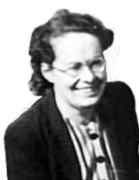Person: Clarke (2), Joan

Joan Clarke was one of the English mathematicians recruited to work on wartime German codes with Alan Turing at Bletchley Park.
Mathematical Profile (Excerpt):
- Joan was educated at Dulwich High School and in 1936 matriculated at Newnham College, Cambridge, to study Mathematics.
- In 1939 Clarke graduated, achieving a double first in Mathematics; however this was merely the title of her degree, as Cambridge did not admit women to "full membership of the body academic" until after the end of the Second World War.
- In 1939 Clarke was awarded the distinguished Philippa Fawcett Prize and in 1939-1940 the Helen Gladstone Scholarship.
- Records describe Clarke as congenial but shy, gentle and kind, non-aggressive and always subordinate to the men in her life; qualities that would allow her to conform within the male dominated world of Bletchley Park.
- Joan Clarke and her colleagues were destined to prove him wrong.
- During her time at Bletchley Park, Clarke only ever knew of one other female mathematical cryptanalyst.
- Clarke was originally paid £2 a week - but as this was an era of female discrimination in the workplace, similarly qualified men received significantly more money.
- Clarke's first promotion at work was to Linguist Grade - even though Clarke did not speak another language - this promotion was engineered to enable her to earn extra money - thereby acknowledging her workload and contributions to the team.
- The Deputy Director at Bletchley Park, Commander Edward Travis, later told her that she might have to enroll in the WRNS (Women's Royal Naval Service) in order to earn significantly more money, but Clarke did not wish to pursue this route.
- In Hut 8, Clarke was quickly promoted to her own table in a small room, joining a team which included Alan Turing, Tony Kendrick and Peter Twinn.
- The fact that Joan Clarke was able to move so quickly into the male cryptology area at Bletchley Park indicates she possessed these attributes.
- Joan Clarke's first task on arriving at Bletchley Park was to use a new key-finding aid called the Bombe, against the recovered data.
- This successfully resulted in Clarke and her colleagues breaking approximately six days of April traffic over a period of three months.
- This provided Clarke and the team, with the knowledge of what information to expect in a message and how the Naval indicator system worked.
- There were eight male Banburists and Joan Clarke was the only female Banburist.
- Shortly afterwards, Clarke devised a method of her own to also speed up the technique, and she was told, to her surprise, that she had used pure Dillysimus.
- Clarke and her co-workers successfully performed Banburismus for two years, only stopping in August 1943 when ultra fast Bombes became available.
- In the spring of 1941, Joan Clarke developed a close friendship with her Hut 8 colleague Alan Turing.
- Soon after this blossoming friendship, Turing proposed marriage and Clarke accepted.
- Turing expected this to be the end of their affair, but Clarke was undeterred by his declaration, and their engagement continued.
- They shared many interests, both were keen chess players and, as Clarke had studied Botany at school, she could become involved with Turing's life long enthusiasm of the growth and form of plant life.
- When Turing wrote his account of the Enigma Theory for the use of new recruits in Hut 6 and Hut 8, (known at Bletchley Park as "Prof's book") he used Joan Clarke as his 'guinea pig' - she had to read and trial it, checking that it was understandable for them.
- Clarke was to remain friends with Turing for the rest of his life.
- Years later, after they had both left Bletchley Park, Turing revealed in a letter to Clarke that he "did occasionally practice" his homosexuality and that he had been "found out".
- As well as continuing to break the Dolphin Enigma, Clarke and the Naval Enigma team were allotted responsibility for breaking the Shark Enigma - codename for the 4-rotor key introduced in late 1941.
- However, Joan Clarke remained in Hut 8, becoming Deputy Head in early 1944.
- In 1947, Clarke was appointed a Member of the British Empire (MBE) for her codebreaking expertise during the war, but due to the restraints of the Official Secrets Act, her work was to remain confidential for many years to come.
- Clarke transferred to Bletchley Park's successor and there she met a colleague named Lieutenant-Colonel J (Jock) K R Murray, a retired army officer, whom she went on to marry in 1952.
- They returned to Cheltenham in 1962 and Clarke rejoined the GCHQ where she remained until retiring at the age of 60 in 1977.
- In 1987, Clarke was awarded the Sandford Saltus Medal - the Society's premier distinction, voted for by its members for scholarly contributions to British Numismatics.
- After her retirement, Clarke also assisted Sir Harry Hinsley on what became Appendix 30 to Volume 3, Issue 2 of the 1988 British Intelligence in the Second World War, a substantially revised assessment of the Polish, French and British contributions to breaking the Enigma.
- Whitmore based the character in the play named Pat Smith, on Joan Clarke.
- Joan Clarke died at her home in Headington, Oxford.
- The full extent of Joan Clarke's mathematical contributions and accomplishments at Bletchley Park remain unknown, because of the continuing secrecy amongst cryptanalysts.
- Furthermore, Clarke's work is still somewhat overshadowed by her relationship with Alan Turing.
Born 24 June 1917, London, England. Died 4 September 1996, Headington, Oxfordshire, England.
View full biography at MacTutor
Tags relevant for this person:
Origin England, Women
Thank you to the contributors under CC BY-SA 4.0! 

- Github:
-

- non-Github:
- @Lynsey-Ann-Lord
References
Adapted from other CC BY-SA 4.0 Sources:
- O’Connor, John J; Robertson, Edmund F: MacTutor History of Mathematics Archive
